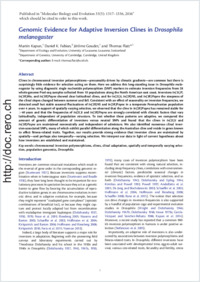Genomic evidence for adaptive inversion clines in Drosophila melanogaster
- Kapun, Martin Department of Ecology and Evolution, University of Lausanne, Switzerland
- Fabian, Daniel K. Department of Genetics, University of Cambridge, United Kingdom
- Goudet, Jérôme Department of Ecology and Evolution, University of Lausanne, Switzerland
- Flatt, Thomas Department of Ecology and Evolution, University of Lausanne, Switzerland
-
01.05.2016
Published in:
- Molecular Biology and Evolution. - 2016, vol. 33, no. 5, p. 1317–1336
English
Clines in chromosomal inversion polymorphisms—presumably driven by climatic gradients—are common but there is surprisingly little evidence for selection acting on them. Here we address this long-standing issue in Drosophila melanogaster by using diagnostic single nucleotide polymorphism (SNP) markers to estimate inversion frequencies from 28 whole-genome Pool-seq samples collected from 10 populations along the North American east coast. Inversions In(3L)P, In(3R)Mo, and In(3R)Payne showed clear latitudinal clines, and for In(2L)t, In(2R)NS, and In(3R)Payne the steepness of the clinal slopes changed between summer and fall. Consistent with an effect of seasonality on inversion frequencies, we detected small but stable seasonal fluctuations of In(2R)NS and In(3R)Payne in a temperate Pennsylvanian population over 4 years. In support of spatially varying selection, we observed that the cline in In(3R)Payne has remained stable for >40 years and that the frequencies of In(2L)t and In(3R)Payne are strongly correlated with climatic factors that vary latitudinally, independent of population structure. To test whether these patterns are adaptive, we compared the amount of genetic differentiation of inversions versus neutral SNPs and found that the clines in In(2L)t and In(3R)Payne are maintained nonneutrally and independent of admixture. We also identified numerous clinal inversion-associated SNPs, many of which exhibit parallel differentiation along the Australian cline and reside in genes known to affect fitness-related traits. Together, our results provide strong evidence that inversion clines are maintained by spatially—and perhaps also temporally—varying selection. We interpret our data in light of current hypotheses about how inversions are established and maintained.
- Faculty
- Faculté des sciences et de médecine
- Department
- Département de Biologie
- Language
-
- English
- Classification
- Biological sciences
- License
-
License undefined
- Identifiers
-
- RERO DOC 324332
- DOI 10.1093/molbev/msw016
- Persistent URL
- https://folia.unifr.ch/unifr/documents/307597
Statistics
Document views: 123
File downloads:
- pdf: 195
